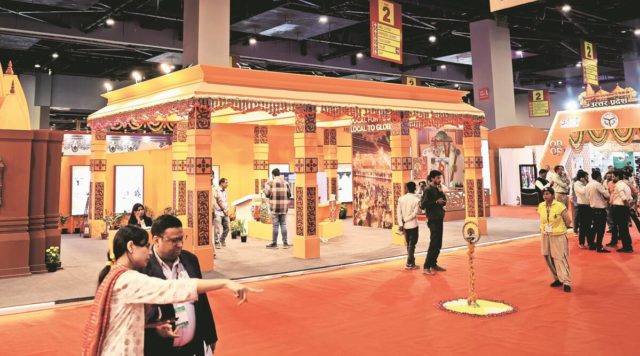Modern trade fairs have evolved from a rich history of networking events and several forms of social interaction. Tracing their roots to Middle Eastern bazaars in 3000 BC, agricultural fairs in 1810 (Massachusetts), and the Great Exhibition of 1851, trade shows still rank among the most lucrative business strategies today.
Despite the advent of virtual trade fairs, physical events are still a common feature in modern societies. The ability to spread awareness, share experiences, and network with peers makes the trading experience worth the effort. The primary aim of trade fairs is to provide pathways for traders and consumers to develop enterprises. It facilitates linkages for businesses to achieve traction and increase their market reach. Trade fairs also allow industries to explore new marketing avenues at a significantly lower price point. These ventures make target marketing simpler and infinitely more effective.
There is a catch, however. Success at trade shows depends on a variety of factors. Specific details such as product information handouts, booth placement, and promotional giveaways require substantial attention to detail. Trade fairs require effective marketing strategies that ensure point-of-sale preparation to increase sales. Finding stands solution helps you customize your booth to fit your needs and increase your product appeal. As you plan for your next trade show, here are a few marketing strategies that will ensure you stand out.
Table of Contents
Pre-event preparations: objectives and goals
A critical phase of any marketing strategy is to define what constitutes event success. You and your team must have a clear set of goals and an evaluation strategy for your achievements at the trade show. Setting goals gives you a reference point and helps you develop a systematic action plan. This process makes it easier to identify target accounts and establish a demographic analysis of your target audience. Knowing what you want to achieve will ensure you develop an effective marketing plan and facilitate a more efficient technique.
Marketing and communication channels
Ensure people know about your brand before the event. While trade fairs are meant for industry exposure, preparing for the event is highly recommended. Companies should leverage technology to boost pre-trade fair visibility and increase outreach. Strategy points like social media, website promotion, and direct email marketing are excellent ways to keep your client network in the loop. Technology marketing, such as hashtags, will spread like wildfire in 2023.
Design tips for your booth layout
Trade fairs are primarily based on aesthetics. Your booth or stand is your first point of sale. Potential customers will instantly respond to a well-designed display stand. Considerations like industry objectives and transaction focus are also critical to your booth layout. It is crucial to base the design on the specific product or service you have on display. For example, a product seller may need a wider booth, perhaps some shelving, to ensure item visibility. A service-oriented enterprise may achieve better results in a smaller, more intimate space.
Booth placement is also a crucial consideration. Accessibility is the primary focus here. Ensure potential customers can easily find your booth, have an obvious entry point, and have minimal obstructions. Attendees won’t be able to find your booth if you have a large signpost blocking the entryway. Work on strategic item placement to ensure effective space utilization but keep it simple. Ensure there is adequate room for people to move around, and ensure your promotional items are displayed in plain sight. Your stand must show people what you sell. Your brand is your most effective selling point at a trade fair. Display high-quality logos to ensure you maximize the opportunity for brand awareness.
Prioritize engagement.
Despite having an attractive display booth, potential leads will only respond to receptive personnel. Another critical selling point is the personal touch. How well do you know your product line? How friendly and attentive are you to clients’ needs? Note that you are the brand ambassador for your product. How you make potential customers respond will significantly affect your conversion rate. Engagement requires courteousness, problem-solving skills, and the ability to maintain meaningful conversations. Engagement at a trade show is the first critical step to establishing potential client trust.
Promotional merchandise as a marketing strategy
A product giveaway is perhaps the most underrated marketing strategy. Dating back to Anheuser-Busch’s custom corkscrew giveaways in 1852, this strategy has evolved into one of the most effective lead-generation exercises at trade fairs. A study by the Promotional Products Association International (PPAI) indicates 52% of potential customers respond positively to product giveaways. Not only does it increase brand awareness, but it also inspires customers to reach out to your company. Lead conversion is 30% more effective for businesses that use promotional merchandise as a marketing strategy.
Product giveaways are also more cost-effective compared to mainstream advertising. According to the Global Advertising Specialists Impressions Study (2014), 83% of trade fair attendees like free merchandise. If the item is of good quality, 74% of people will keep it around for a long time. In principle, promotional giveaways broaden your reach and ensure you generate a higher conversion rate.
Point of sale interaction
A trade fair is not limited to brand awareness; it is an opportunity to make substantial sales. Customers who are genuinely interested in your product will buy it immediately. Ensure you have ready merchandise and are equipped to take payment. A trade fair provides the best opportunity to generate new leads and register record sales. A transaction-ready booth is an excellent way to evaluate your business’s success at the event.
Real-time information
The first strategy emphasizes the use of technology before and during the event. Leverage this utility by posting the latest events at your booth as the event goes on. Social media gives you a great platform to showcase your booth and attract new leads. People can follow your progress on Instagram, Facebook, or YouTube, see your promotions, and tune in virtually. You can also have an online raffle for potential customers to win products at home.








